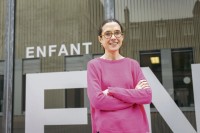Chronic & Non Communicable Diseases
Longevity, Ageing and Long-term Care
Prevention & Personalised Health
Metabolic Health, Diabetes & Obesity
Healthy Ageing & Longevity
Genetics & Omics
Cellular Ageing
AXA Chairs
Spain
2014.03.31
AXA Chair in Longevity
Targeting Age-Dependent Mechanisms that Underpin the Type 2 Diabetes Pandemic
Type 2 diabetes is one of the most common and devastating diseases in our ageing society. It is often silent until it causes chronic complications, including some of the world’s leading causes of blindness, terminal kidney failure, limb amputations, stroke, and heart disease.
Type 2 diabetes arises from a combination of genetic predispositions, lifestyle factors, and age-related processes that cause a progressive failure of pancreatic insulin-producing b-cells. In essence, b-cells from people with type 2 diabetes struggle to cope with increased insulin demands imposed by modern sedentary lifestyle, leading to high blood sugar levels. Our ability to act on this b-cell deficiency is limited by our lack of understanding of the underlying mechanisms.
The AXA Chair led by Prof. Jorge Ferrer at the CRG focuses on deciphering the genetic and epigenetic mechanisms that drive type 2 diabetes, and using this knowledge to develop targeted therapies. This approach aims to tackle the root molecular defects, providing a different type of therapy that complement existing treatments focused on the amelioration of blood sugar levels or weight management.
The team approaches this challenge through various routes. One key strategy is to leverage human genetic studies, which have revealed that people who are born with an increased risk of developing type 2 diabetes carry specific DNA variants, many of which influence how genes get activated in insulin-producing b-cells. Such variants can affect different types of regulatory elements that act as genome switches that turn genes on or off, or tune their expression level. By manipulating these switches, it is possible to correct the core molecular defects underlying some forms of diabetes.
Likewise, the team works to understand how age and lifestyle factors influence these switches, because this holds clues on the interplay between aging, environment, and genetics in the development of type 2 diabetes. Ultimately, these strategies can lead to therapies that go one step beyond temporary improvements, aiming to impact the disease progression. In short, by understanding the mechanisms behind type 2 diabetes, the CRG team hopes to pave the way for more effective and lasting treatments for millions affected by this global health crisis.
This is the second mandate of the AXA Chair in Risk Prediction in Age-Related Diseases, previously held by Prof. Ben Lehner with the project below:
Medicine’s Future is Written in Your Genes
For some years now, we’ve known the entire DNA sequence that makes us human. We often hear that a specific gene has been linked to cancer, to Alzheimer’s, to cardiovascular or other age-related diseases. Yet, do we know what all this means for us individually, who will develop these problems, how much risk each of us carries? Not really. Not yet.
Dr. Ben Lehner leads a team that is making progress towards personalized medicine by advancing our understanding of how genetic information is translated into its physical expression in an organism. The delay up to now in this area of research has been due to the sheer complexity of that process: the extremely sensitive interactions among our biological systems, the influence of external factors like environment and life history, and even the role of random events within our cells. Nevertheless, Dr. Lehner has had success addressing each of these aspects.
His team has examined, for example, the variation among individuals’ DNA sequences and asked if the phenotypes that would result—the physical expression of those genes—could be predicted. Through a large-scale experiment on yeast, they found that even simple genetic models were fairly accurate in predicting how these individual cells would differ on a number of traits. The researchers knew that such genetic variation plays an active role throughout development, yet many analyses consider only the characteristics that result at the end. Dr. Lehner went on to develop a method of tracking the influence of genetic variation on development itself—in this case, in the common lab organism, C. elegans. “This approach,” he explains, “could be used to study how genetic variation influences any dynamic process such as human development or disease progression.”
Another angle of his research focuses on the impact of random events affecting our genes. A long-term accumulation of errors in the DNA may not be necessary to trigger the development of cancer; a single mutation in a cell can be all it takes. Indeed, this is a frequent cause of the disease, the researchers discovered. The Lehner team identified precisely how, at the level of our genes, one class of such mutations leads to cancer, and noted that the rate at which mutations occur varies greatly, but predictably, across the entire set of human genes. This, they worked out, is mainly due to differences in the efficiency of the cellular system for DNA repair.
This wealth of knowledge that Dr. Lehner’s team has produced regarding what controls and influences the physical expression of genetic information is poised to offer great insight into the medical reality written in our genes. Such information will participate in the coming revolution aimed at personalizing medical treatment to every individual, for a better targeted, more effective fight against the troubles of aging and disease.
To add or modify information on this page, please contact us at the following address: community.research@axa.com
Related articles
Chronic & Non Communicable Diseases
Medical Treatment & Drug Development
Chronic Pain & Musculoskeletal Disorders
Drug Delivery
Biotech- and Nanotechnology
AXA Project
France
Pain Pediatric & Elderly AXA Research Lab (PEARL)
Chronic pain is recognized as a major public health problem affecting patients in their daily activity, physical and mental health,... Read more

Celine
GRECO



.thumbnail.jpg)